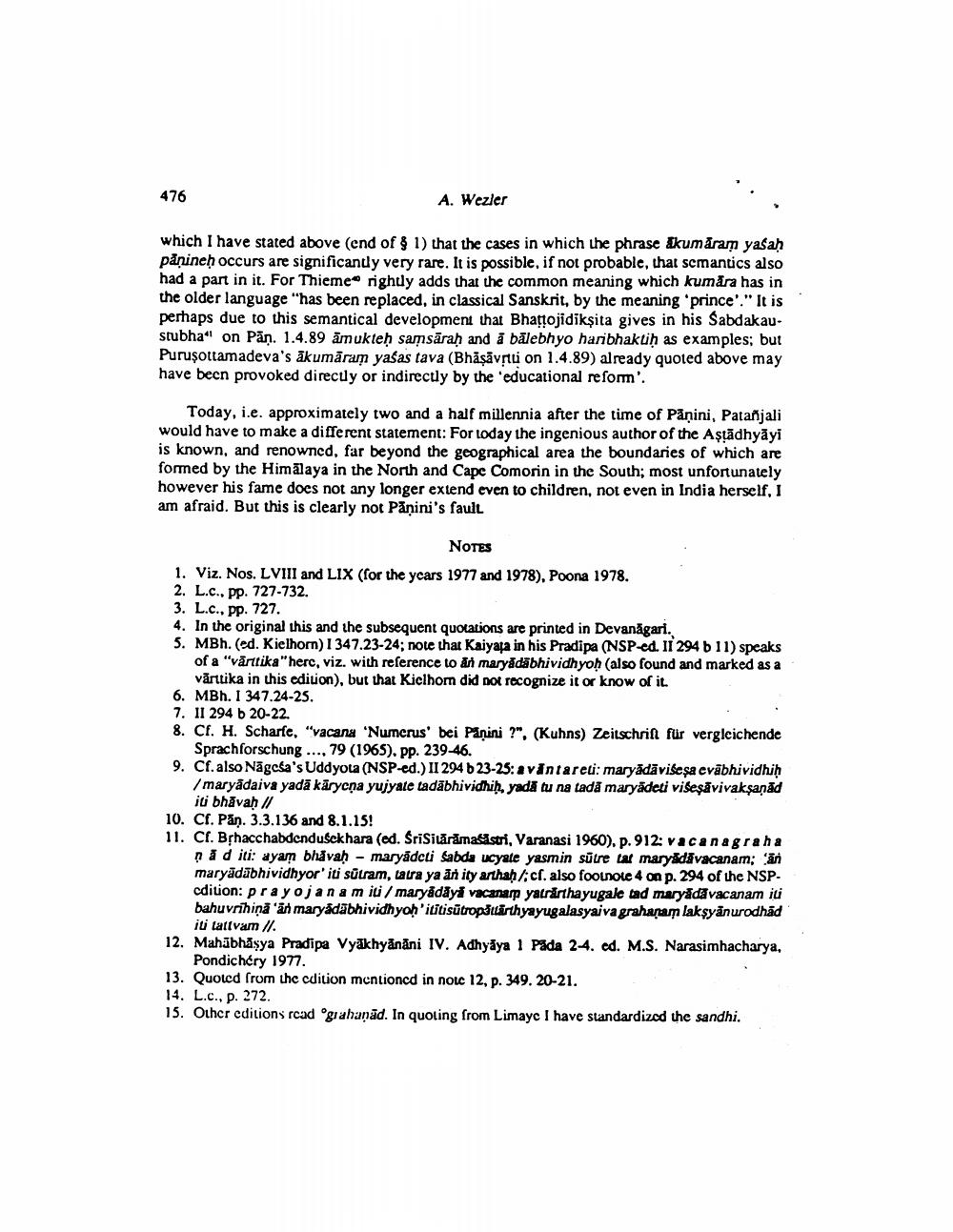Book Title: How Far Did Paninis Fame Really Extend In Patanjalis View Author(s): A Wezler Publisher: A Wezler View full book textPage 9
________________ 476 A. Wezler which I have stated above (end of § 1) that the cases in which the phrase akumāram yaśaḥ panineḥ occurs are significantly very rare. It is possible, if not probable, that semantics also had a part in it. For Thieme rightly adds that the common meaning which kumara has in the older language "has been replaced, in classical Sanskrit, by the meaning 'prince'." It is perhaps due to this semantical development that Bhattojidikṣita gives in his Sabdakaustubha" on Pan. 1.4.89 amukteḥ samsaraḥ and a balebhyo haribhaktiḥ as examples; but Purusottamadeva's ākumāram yasas tava (Bhāṣāvṛtu on 1.4.89) already quoted above may have been provoked directly or indirectly by the 'educational reform'. Today, i.e. approximately two and a half millennia after the time of Panini, Patanjali would have to make a different statement: For today the ingenious author of the Aṣṭādhyāyi is known, and renowned, far beyond the geographical area the boundaries of which are formed by the Himalaya in the North and Cape Comorin in the South; most unfortunately however his fame does not any longer extend even to children, not even in India herself, I am afraid. But this is clearly not Panini's fault NOTES 1. Viz. Nos. LVIII and LIX (for the years 1977 and 1978), Poona 1978. 2. L.c., pp. 727-732. 3. L.c., pp. 727. 4. In the original this and the subsequent quotations are printed in Devanagari. 5. MBh. (ed. Kielhorn) 1 347.23-24; note that Kaiyata in his Pradipa (NSP-ed. II 294 b 11) speaks of a "värttika" herc, viz. with reference to an maryadabhividhyoḥ (also found and marked as a vārttika in this edition), but that Kielhor did not recognize it or know of it. 6. MBh. I 347.24-25. 7. II 294 b 20-22. 8. Cf. H. Scharfe, "vacana 'Numerus' bei Panini ?", (Kuhns) Zeitschrift für vergleichende Sprachforschung..., 79 (1965). pp. 239-46. 9. Cf. also Nāgesa's Uddyota (NSP-ed.) II 294 b 23-25: a vantaret: maryadavišeşa evabhividhiḥ /maryādaiva yadā kārycṇa yujyate tadabhividhiḥ, yadā tu na tada maryadeti višeṣāvivakṣaṇād iti bhavaḥ // 10. Cf. Pan. 3.3.136 and 8.1.15! 11. Cf. Bṛhacchabdendusekhara (ed. ŚriSitaramasastri, Varanasi 1960), p. 912: vacanagraha nad iti: ayam bhavaḥ - maryadeti Sabda ucyate yasmin sütre tat maryādāvacanam; an maryädäbhividhyor' iti sūtram, tatra ya än ity arthaḥ/; cf. also footnote 4 on p. 294 of the NSPcdition: prayojana miti/maryädäyä vacanam yaträrthayugale tad maryadavacanam iti bahuvrihiņā 'än maryadabhividhyoḥ'ititisütropättärthyayugalasyaiva grahanam laksyanurodhād iti tattvam //. 12. Mahābhāṣya Pradipa Vyakhyānāni IV. Adhyāya 1 Pada 2-4. ed. M.S. Narasimhacharya, Pondichery 1977. 13. Quoted from the edition mentioned in note 12, p. 349. 20-21. 14. L.c., p. 272. 15. Other editions read grahanad. In quoting from Limaye I have standardized the sandhi.Page Navigation
1 ... 7 8 9 10 11
